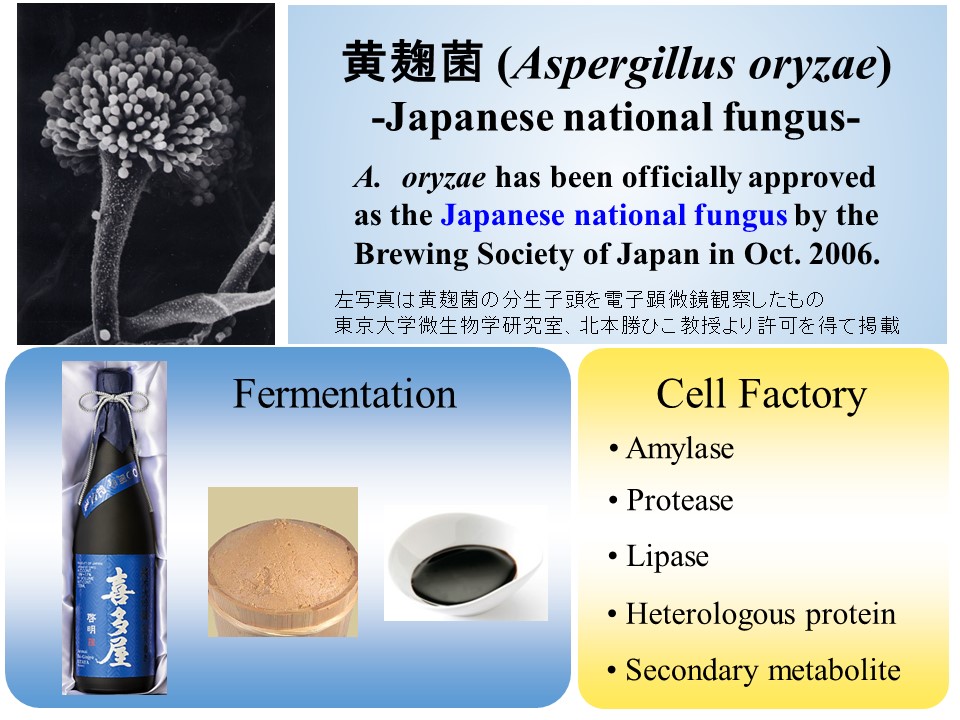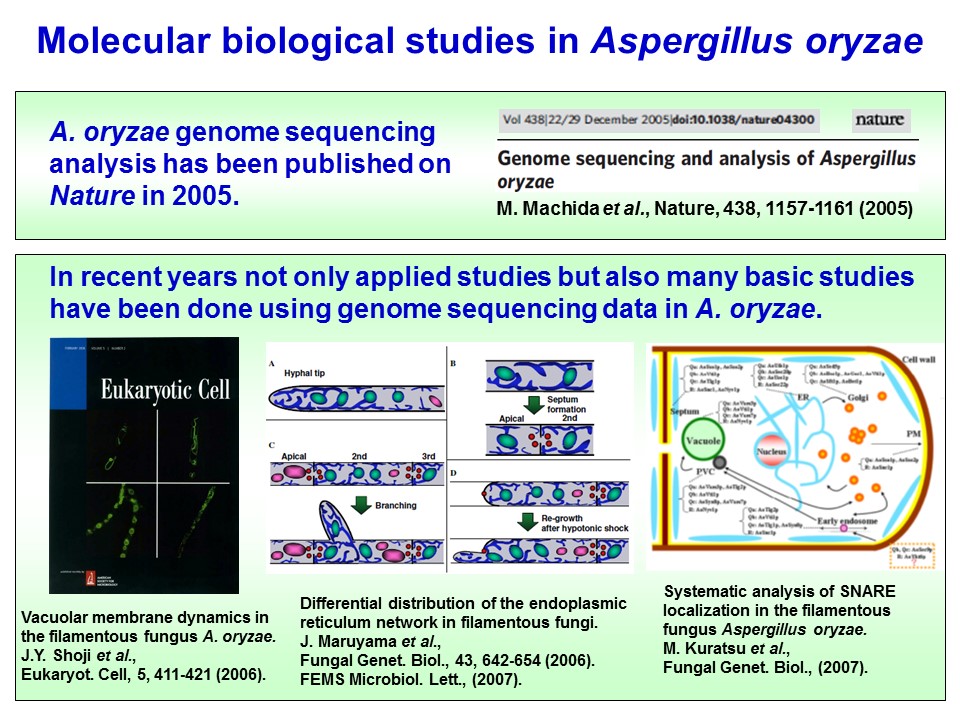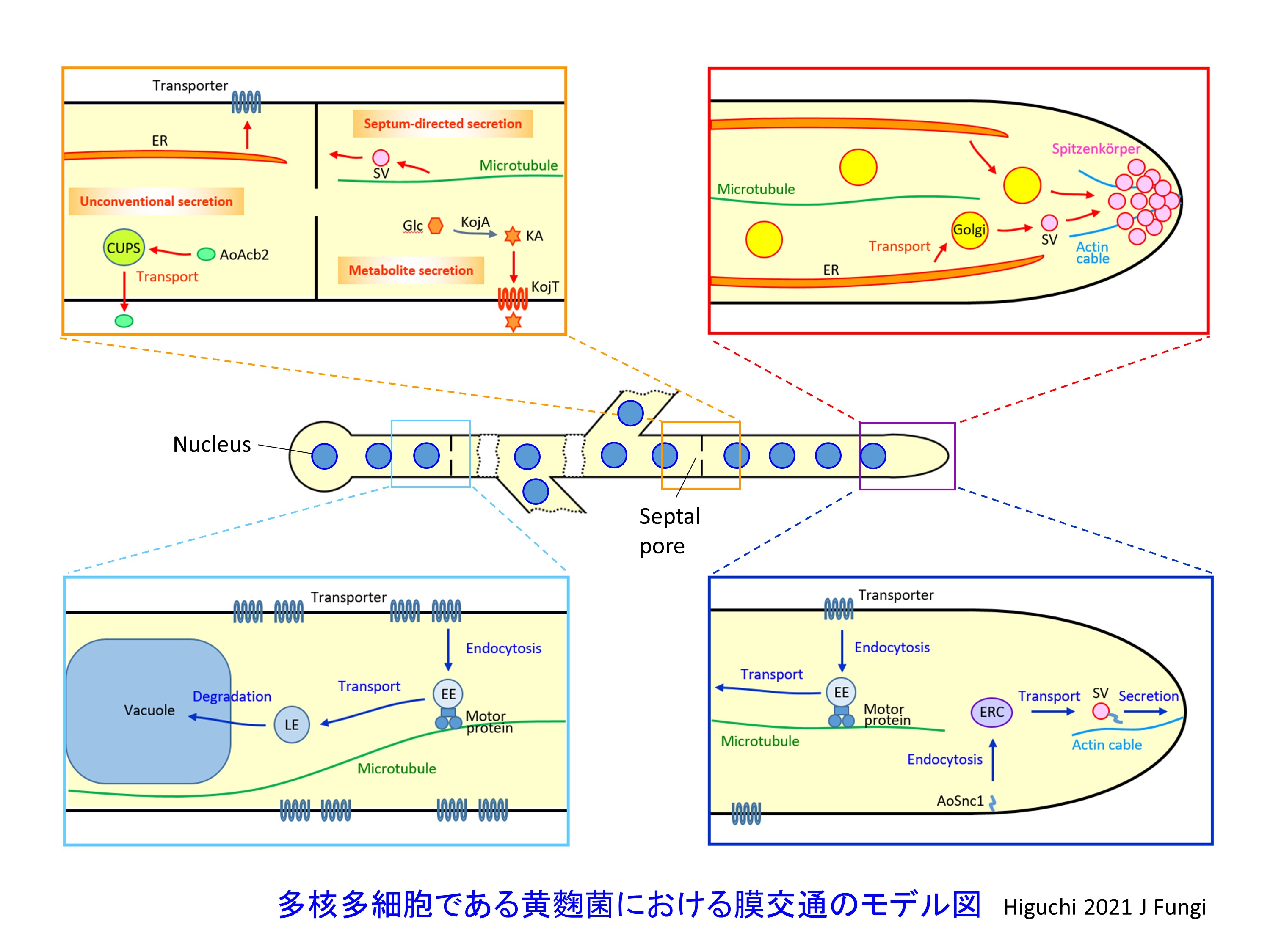Why do we investigate A. oryzae?
The yellow Koji mold Aspergillus oryzae is a useful microorganism that has long been used in the fermentation and brewing industries in Japan, such as sake, miso and soy sauce, and is recognised by GRAS (Generally Regarded As Safe) as a highly safe fungus. For this reason, in October 2006, the yellow Koji mold was recognised as the national fungus together with the white and black Koji molds at the Brewing Society of Japan. The yellow Koji mold has an extremely high capacity to secrete useful enzymes and secondary metabolites such as amylases and kojic acid outside the cell. Using these properties, a number of studies have been conducted to produce large quantities of useful substances for us humans in a safe manner. Furthermore, since genome editing on foodstuffs was lifted in October 2019, new developments are expected in the fermentation and brewing industries through further cell biological understandings and molecular breeding of the yellow Koji mold.

A. oryzae as a model organism
As described above, A. oryzae was known since old times, but sexual generation has not yet been confirmed, which makes this fungus arduous to handle by traditional genetic research methods. Furthermore, A. oryzae is a multi-cellular organism with several nuclei, which also makes this microbe hard to use. Thus, A. oryzae had been analyzed only in applied biology, but not in fundamental biology. However, in 2005, A. oryzae genome sequencing analysis has been completed and published in Nature, conducted by the Japanese consortium of A. oryzae genome analysis. Using this very useful information, reverse genetics have become to be easily done (Machida et al., 2005). Moreover, molecular biological techniques have been established, such as the Multi-Site Gateway system that allows generation of expression plasmids much easier and quicker (Mabashi et al., 2006). Together with Neurospora crassa and Aspergillus nidulans whose genomes have also been already analyzed, A. oryzae has been recognized as a model organism of filamentous fungi with respect to both in applied and basic sciences. In fact, by cellular biological approaches using GFP (Green Fluorescence Protein), organelles and thier marker proteins have been well analyzed (Maruyama et al., 2006; Shoji et al., 2006; Kuratsu et al., 2007).

Valuable heterologous protein production in A. oryzae
Is it indeed easy to produce plenty of valuable heterologous proteins by A. oryzae cells? Unfortunately, the answer is "No" so far. Generally, to introduce genes encoding valuable heterologous proteins into A. oryzae renders to obtain much less amount of proteins than native ones. It is likely because heterologous proteins are not efficiently translated and/or secreted and can be degraded by extracellular proteases in the culture supernatant. In fact, by removing such potential hindrances, there are many reports in which valuable proteins could be produced more (Nemoto et al., 2009; Yoon et al., 2010; Ohno et al., 2011; Yoon et al., 2011).
How to produce valuable heterologous proteins in A. oryzae ? ~Approach by cell biology~
Then hereafter, how valuable heterologous proteins can be produced in A. oryzae? We focus on protein secretion pathway. After synthesized by ribosomes, secretory proteins are transported through endoplasmic reticulum (ER) and Golgi aparatus and secreted from the plasma membrane to outside the cells. In these steps, secretory proteins are transported inside vesicles coated with lipid bilayer, the process of which is called vesicular trafficking. Intracellular vesicular trafficking pathway includes not only secretory pathway but also endocytic pathway, by which molecules are incorporated from the plasma membrane into inside cells. In addition, intracellular vesicular trafficking pathway is important not only for trafficking molecules but also for maintaining the balance of lipid bilayer inside cells. Therefore, by analysing endocytic pathway as well as secretory pathway, we are trying to find out a new approach for valuable heterologous protein production.
Membrane traffic study in A. oryzae
Membrane traffic, as the name implies, refers to the intracellular material transport pathway among organelles across lipid membranes, including the vesicular transport pathway (Higuchi, 2021a,b). An example of characteristic membrane traffic in filamentous fungi, including A. oryzae, is early endosomal dynamics. Early endosomes, organelles of the endocytotic pathway, move at a rate of approximately 2 micrometres per second in the elongated hyphal cells. It is now clear that this early endosome dynamics is important for the subcellular distribution of polysomes (multiple ribosome-bound mRNAs), which are protein translation structures (Higuchi et al., 2014; summarised in Higuchi and Steinberg, 2015). Furthermore, in A. oryzae, early endosomal dynamics have been found to be important for α-amylase production and cell differentiation (Togo et al., 2017). At the same time, analyses of protein-specific secretion pathways (Kwon et al., 2017), secreted glycoprotein modifications (Li et al., 2020) and protein quality control mechanisms (Morita et al., 2020) have also been conducted.
Spatiotemporal expression regulation in multicellular and multinuclear A. oryzae
Furthermore, we have recently clarified the localisation of mRNAs encoding α-amylase, the actin cytoskeleton and the EGFP-fused proteins in the multicellular and multinuclear A. oryzae (Higuchi and Takegawa, 2020; Morita et al., 2021). In the future, we intend to analyse where and when genes encoding useful substances and factors related to their biosynthesis are expressed in the cell, in order to reveal the whole picture of the biosynthetic mechanisms of useful substances in space and time. By clarifying the various molecular mechanisms in these membrane traffic pathways and successfully regulating the intracellular transport mechanisms, we aim to breed A. oryzae strains that produce more useful substances.

Contact
Yujiro Higuchi: y.higuchiアットagr.kyushu-u.ac.jp (change アット to @)